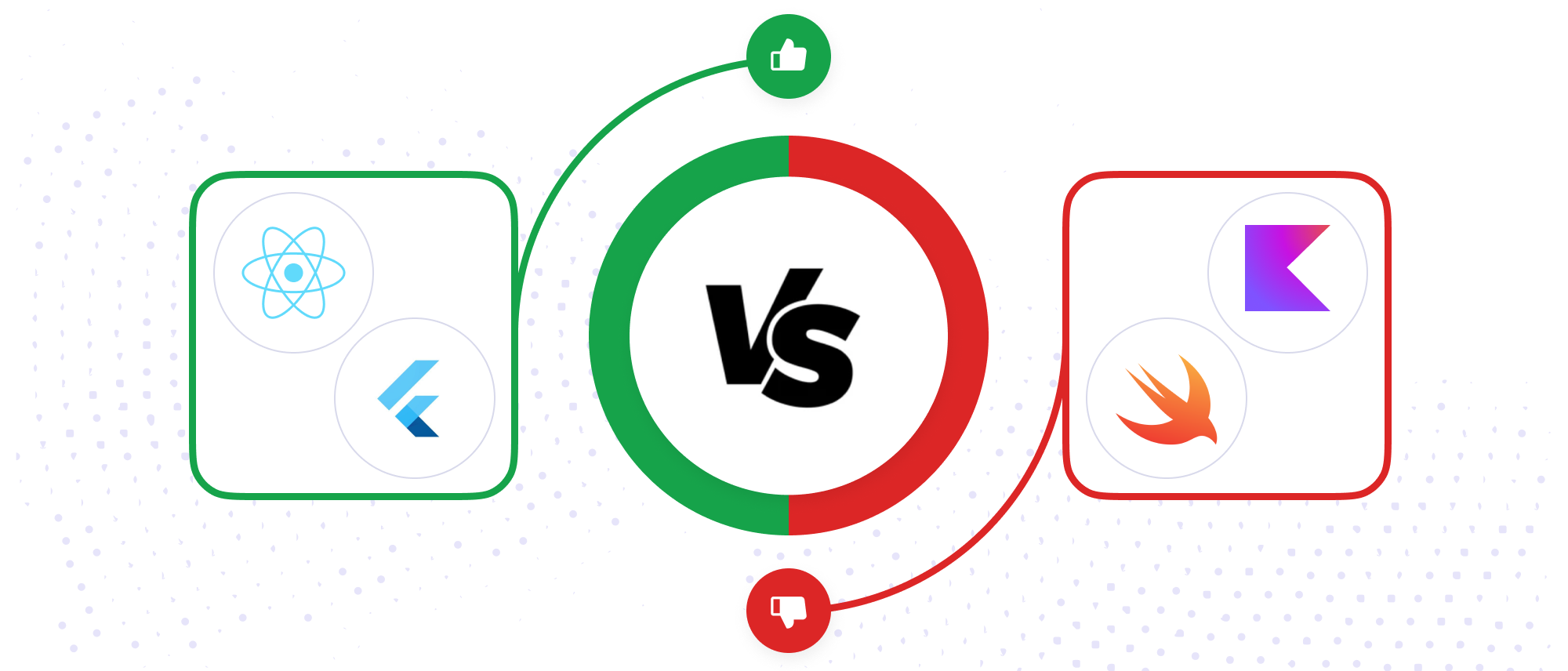Why Do React Native & Flutter Outperform Kotlin & Swift?

As the mobile app development landscape continues to evolve, businesses are faced with a daunting decision: should they stick with native languages like Kotlin and Swift, or take the hybrid route with React Native and Flutter?
In this blog, we'll explore the benefits of using hybrid technology, debunk common myths, and provide technical examples to demonstrate why React Native and Flutter are a better choice for many businesses.
In recent years, hybrid apps have gained significant traction, with many large companies ditching their native apps in favour of hybrid solutions.
For instance, Walmart, one of the world's largest retailers, uses React Native. Similarly, Instagram, a Facebook-owned company, developed its mobile app using React Native. These companies, along with many others, have recognized the benefits of hybrid technology, including:
1. Reduced Development Time and Cost
Hybrid technologies allow developers to write code once and deploy it on both Android and iOS platforms. This approach can significantly reduce development time and cost compared to building separate native apps for each platform.
- Time Savings: Developers can create a single codebase that works on both platforms, potentially cutting development time by up to 30-40%.
- Cost Reduction: With less development time and the need for fewer platform-specific developers, you can expect to save 20-30% or more on development costs.
2. Easier Maintenance and Updates
Maintaining a single codebase is simpler and more cost-effective than managing separate codebases for Android and iOS.
- Streamlined Updates: When you need to add features or fix bugs, you only need to do it once, saving time and reducing the chance of platform-specific issues.
- Consistent User Experience: It's easier to maintain a consistent look and feel across platforms when using a single codebase.
3. Faster Time-to-Market
In today's competitive landscape, getting your app to market quickly can be crucial.
- Rapid Prototyping: Hybrid technologies often come with pre-built components and libraries, allowing for faster prototyping and development.
- Simultaneous Launch: You can launch on both Android and iOS simultaneously, maximizing your initial market reach.
4. Flexibility in Hiring
Hybrid technologies often use popular web technologies like JavaScript, making it easier to find developers.
- Larger Talent Pool: More developers are familiar with web technologies compared to platform-specific languages, potentially reducing hiring costs and time.
- Cross-Platform Skills: Developers skilled in hybrid technologies can work on both platforms, increasing team flexibility.
Technical Advantages of Hybrid Apps
While hybrid apps may not offer the same level of native performance, they have made significant strides in recent years. React Native and Flutter, in particular, have closed the gap with native languages like Kotlin and Swift. Here are some technical advantages of hybrid apps:
- Shared Codebase: Hybrid apps can share code across multiple platforms, reducing development time and resources.
- Hot Reload: React Native and Flutter offer hot reload functionality, allowing developers to see changes in real-time, without the need for a full rebuild.
- Native Modules: Both React Native and Flutter provide native modules, which allow developers to access native functionality and APIs.
- Performance: Hybrid apps have made significant improvements in performance, with many apps rivaling native apps in terms of speed and responsiveness.
- Just-in-Time (JIT) Compilation: React Native and Flutter use JIT compilation to optimize code execution, reducing the performance gap with native apps.
- Optimized Bridge Implementations: React Native has optimized bridge implementations, which reduce the overhead of communicating between JavaScript and native code. Flutter on the other hand compiles directly to Native code.
- Access to Native APIs: Hybrid apps can access native APIs, such as cameras, GPS, and other device-specific features, using native modules.
- Pixel-Perfect Rendering: Flutter uses its own rendering engine to create pixel-perfect UI components that look native on both platforms.
While both React Native and Flutter offer significant advantages over native development for many projects, each has its own strengths and use cases. If you're considering hybrid development but unsure which framework to choose, our in-depth comparison of Flutter vs react native can help you determine which one best suits your specific project needs.
When Hybrid Apps Aren't a Good Fit
While hybrid apps offer many benefits, they may not be suitable for every project. Here are some scenarios where native languages like Kotlin and Swift may be a better choice:
- High-Performance Requirements: If your app requires extreme performance, such as gaming or video editing, native languages may be a better choice.
- Complex Native Integration: If your app requires complex native integration, such as accessing native hardware or APIs, native languages may be a better choice.
- Custom UI Requirements: If your app requires a highly customized UI, native languages may be a better choice.
- Real-Time Features and Advanced Animations: If your app requires real-time features, such as live streaming or highly advanced animations, native development might be a better choice.
Frequently Asked Questions?
1. Are hybrid apps slower than native apps?
While this may have been true in the past, hybrid apps have made significant improvements in performance. Just-in-Time (JIT) compilation and optimized bridge implementations in frameworks like React Native have drastically reduced the performance gap.
2. Are hybrid apps less secure than native apps?
Both React Native and Flutter provide robust security features, including encryption and secure storage.
3. Can hybrid apps access native functionality?
Both React Native and Flutter provide native modules, which allow developers to access native functionality and APIs. React Native and Flutter both offer direct bindings to native components, allowing access to camera, GPS, and other device-specific features.
4. Do hybrid apps provide a native look and feel?
Modern hybrid frameworks can closely mimic native UI components and behaviors. Flutter uses its own rendering engine to create pixel-perfect UI components that look native on both platforms. React Native uses platform-specific UI components under the hood.
5. Is it harder to get hybrid apps approved in app stores?
App store approval processes don't discriminate against hybrid apps. As long as your app meets the store guidelines and provides a good user experience, the underlying technology doesn't matter to app store reviewers.
Conclusion
In conclusion, React Native and Flutter offer many benefits over native languages like Kotlin and Swift. With their shared codebase, hot reload functionality, and native modules, hybrid apps can be developed and deployed faster, with less resources and cost. While native languages may be a better choice for certain projects, hybrid apps are a viable option for many businesses. By choosing React Native or Flutter, businesses can reduce development time and resources, increase flexibility, and get their products to market quickly.
Looking for a Flutter app development company to help navigate these choices? F22 Labs specializes in both native and hybrid app development, with particular expertise in Flutter. Our team can assess your business needs and recommend the most efficient approach for your project, whether that's Flutter, React Native, or native development. With our technical expertise and business-focused mindset, we deliver high-performance applications that align with your objectives and budget constraints. Contact us today to discuss how we can accelerate your mobile app journey.
